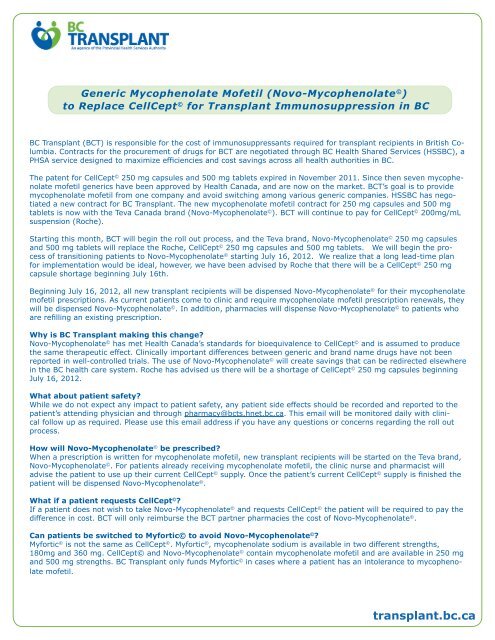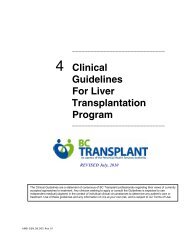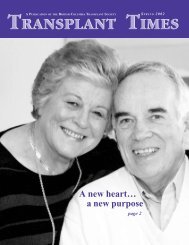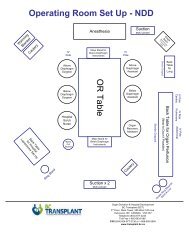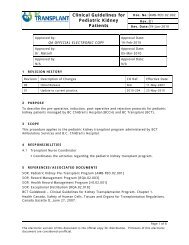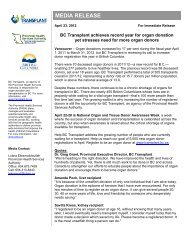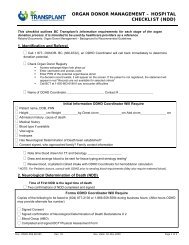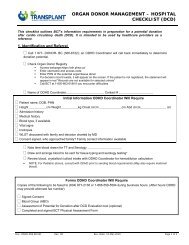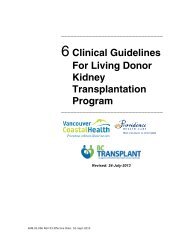Mycophenolate Health Provider Information
Mycophenolate Health Provider Information
Mycophenolate Health Provider Information
Create successful ePaper yourself
Turn your PDF publications into a flip-book with our unique Google optimized e-Paper software.
Generic <strong>Mycophenolate</strong> Mofetil (Novo-<strong>Mycophenolate</strong> © )<br />
to Replace CellCept © for Transplant Immunosuppression in BC<br />
BC Transplant (BCT) is responsible for the cost of immunosuppressants required for transplant recipients in British Columbia.<br />
Contracts for the procurement of drugs for BCT are negotiated through BC <strong>Health</strong> Shared Services (HSSBC), a<br />
PHSA service designed to maximize efficiencies and cost savings across all health authorities in BC.<br />
The patent for CellCept © 250 mg capsules and 500 mg tablets expired in November 2011. Since then seven mycophenolate<br />
mofetil generics have been approved by <strong>Health</strong> Canada, and are now on the market. BCT’s goal is to provide<br />
mycophenolate mofetil from one company and avoid switching among various generic companies. HSSBC has negotiated<br />
a new contract for BC Transplant. The new mycophenolate mofetil contract for 250 mg capsules and 500 mg<br />
tablets is now with the Teva Canada brand (Novo-<strong>Mycophenolate</strong> © ). BCT will continue to pay for CellCept © 200mg/mL<br />
suspension (Roche).<br />
Starting this month, BCT will begin the roll out process, and the Teva brand, Novo-<strong>Mycophenolate</strong> © 250 mg capsules<br />
and 500 mg tablets will replace the Roche, CellCept © 250 mg capsules and 500 mg tablets. We will begin the process<br />
of transitioning patients to Novo-<strong>Mycophenolate</strong> © starting July 16, 2012. We realize that a long lead-time plan<br />
for implementation would be ideal, however, we have been advised by Roche that there will be a CellCept © 250 mg<br />
capsule shortage beginning July 16th.<br />
Beginning July 16, 2012, all new transplant recipients will be dispensed Novo-<strong>Mycophenolate</strong> © for their mycophenolate<br />
mofetil prescriptions. As current patients come to clinic and require mycophenolate mofetil prescription renewals, they<br />
will be dispensed Novo-<strong>Mycophenolate</strong> © . In addition, pharmacies will dispense Novo-<strong>Mycophenolate</strong> © to patients who<br />
are refilling an existing prescription.<br />
Why is BC Transplant making this change?<br />
Novo-<strong>Mycophenolate</strong> © has met <strong>Health</strong> Canada’s standards for bioequivalence to CellCept © and is assumed to produce<br />
the same therapeutic effect. Clinically important differences between generic and brand name drugs have not been<br />
reported in well-controlled trials. The use of Novo-<strong>Mycophenolate</strong> © will create savings that can be redirected elsewhere<br />
in the BC health care system. Roche has advised us there will be a shortage of CellCept © 250 mg capsules beginning<br />
July 16, 2012.<br />
What about patient safety?<br />
While we do not expect any impact to patient safety, any patient side effects should be recorded and reported to the<br />
patient’s attending physician and through pharmacy@bcts.hnet.bc.ca. This email will be monitored daily with clinical<br />
follow up as required. Please use this email address if you have any questions or concerns regarding the roll out<br />
process.<br />
How will Novo-<strong>Mycophenolate</strong> © be prescribed?<br />
When a prescription is written for mycophenolate mofetil, new transplant recipients will be started on the Teva brand,<br />
Novo-<strong>Mycophenolate</strong> © . For patients already receiving mycophenolate mofetil, the clinic nurse and pharmacist will<br />
advise the patient to use up their current CellCept © supply. Once the patient’s current CellCept © supply is finished the<br />
patient will be dispensed Novo-<strong>Mycophenolate</strong> © .<br />
What if a patient requests CellCept © ?<br />
If a patient does not wish to take Novo-<strong>Mycophenolate</strong> © and requests CellCept © the patient will be required to pay the<br />
difference in cost. BCT will only reimburse the BCT partner pharmacies the cost of Novo-<strong>Mycophenolate</strong> © .<br />
Can patients be switched to Myfortic© to avoid Novo-<strong>Mycophenolate</strong> © ?<br />
Myfortic © is not the same as CellCept © . Myfortic © , mycophenolate sodium is available in two different strengths,<br />
180mg and 360 mg. CellCept© and Novo-<strong>Mycophenolate</strong> © contain mycophenolate mofetil and are available in 250 mg<br />
and 500 mg strengths. BC Transplant only funds Myfortic © in cases where a patient has an intolerance to mycophenolate<br />
mofetil.<br />
transplant.bc.ca
What are the similarities between CellCept © and Novo-<strong>Mycophenolate</strong> © ?<br />
Novo-<strong>Mycophenolate</strong> © and CellCept © have the identical active ingredient, mycophenolate mofetil. Novo- <strong>Mycophenolate</strong><br />
© has met <strong>Health</strong> Canada’s standards for bioequivalence as compared to the brand name drug CellCept © . Bioequivalent<br />
drug formulations have the same bioavailability; that is the same rate and extent of absorption. As Novo-<br />
<strong>Mycophenolate</strong> © is bioequivalent to CellCept © it is assumed Novo-<strong>Mycophenolate</strong> © will produce the same therapeutic<br />
effect as CellCept © .<br />
What are the differences between CellCept © and Novo-<strong>Mycophenolate</strong> © ?<br />
Although the active ingredients are the same, the excipients (inactive ingredients) may differ between CellCept © and<br />
Novo-<strong>Mycophenolate</strong> © . This is important in rare cases when a patient has an allergy or sensitivity to one of the excipients.<br />
The biggest difference is cost. Novo-<strong>Mycophenolate</strong> © is less expensive than CellCept © . Novo-<strong>Mycophenolate</strong> © is<br />
slightly different in colour, shape, and markings to CellCept ©<br />
Novo-<strong>Mycophenolate</strong> © looks like this:<br />
Novo-<strong>Mycophenolate</strong> ©<br />
250 mg capsules<br />
Novo-<strong>Mycophenolate</strong> ©<br />
500 mg capsules<br />
Novo-<strong>Mycophenolate</strong> © replaces the CellCept © (pictured below).<br />
CellCept © 250 mg capsules<br />
CellCept © 500 mg capsules<br />
What about the variance in drug concentration?<br />
There is a common misconception that generic drug concentrations can be 80% to 125% of the brand name formulation;<br />
in other words, the variance may be up to 45%. This is not true.<br />
One of the key parameters for bioequivalence is the area under the curve (AUC). The AUC is a mathematical calculation<br />
based on a graph of blood concentration versus time, and it correlates well with total drug exposure. (see<br />
attached graphs of the results of the bioequivalence studies performed by Teva © for 250 mg capsules and 500 mg tablets<br />
compared to CellCept © 250 mg capsules and 500 mg tablets). The AUC of a generic formulation must be no less<br />
than 80% or no more than 125% of the brand name formulation. There is international consensus that differences<br />
less than this are not clinically significant.<br />
More importantly, the 90% confidence interval of AUC must also fall within 80% to 125%. The confidence interval is a<br />
range of measurements within which we can be confident the true result lies. Therefore as the entire confidence interval<br />
is to fall within the 80% to 125% range, the variance is generally less than 5%.<br />
References<br />
1. Canadian <strong>Health</strong> Services Research Foundation [Internet]. Ottawa: CHSRF. Myth: generic drugs are lower quality and less safe than brand name drugs; 2007 Jun [cited 2012<br />
July 3]. Available from: http://www.chsrf.ca/PublicationsAndResources/Mythbusters/ArticleView/07-06-01/0f090ed6-335a-463a-8cf0-55df449fc2c8.aspx<br />
2. Kesselheim AS. The backlash against bioequivalence and the interchangeability of brand-name and generic drugs... CMAJ. 2011;183:1350-1352.<br />
4. Canadian Agency for Drugs and Technologies in <strong>Health</strong> [Internet]. Ottawa: CADTH Similarities and differences between brand name and generic drugs;2012 [ cited 2012 May<br />
1] Available from: http://www.cadth.ca/en/resources/generics/similarities<br />
5. Canadian Agency for Drugs and Technologies in <strong>Health</strong> [Internet]. Ottawa: CADTH What are bioavailability and bioequivalence;2012 [ cited 2012 May 1] Available from: http://<br />
www.cadth.ca/en/resources/generics<br />
6. Rath T. Generic immunosuppressive drugs in kidney Transplantation. European Nephrology.2010;5:56-60.<br />
The views and opinions expressed are those of the author and not necessarily those of any particular manufacturer.<br />
transplant.bc.ca
BC Transplant was granted permission by Teva Canada July, 2012 to publish these graphs.


